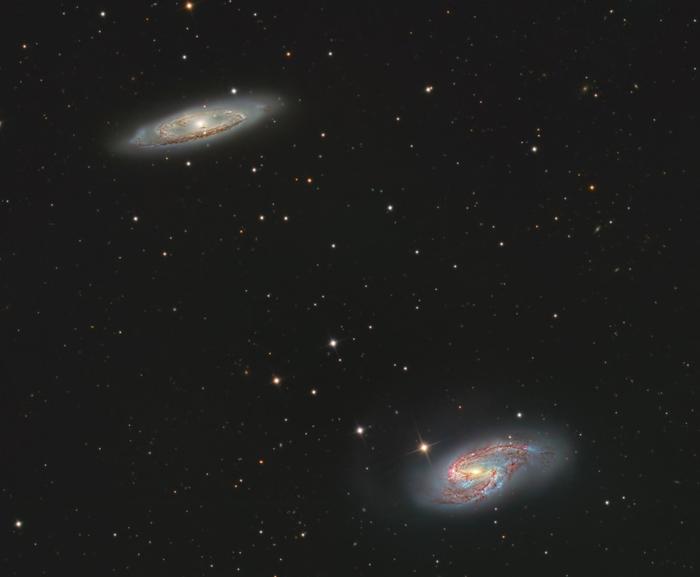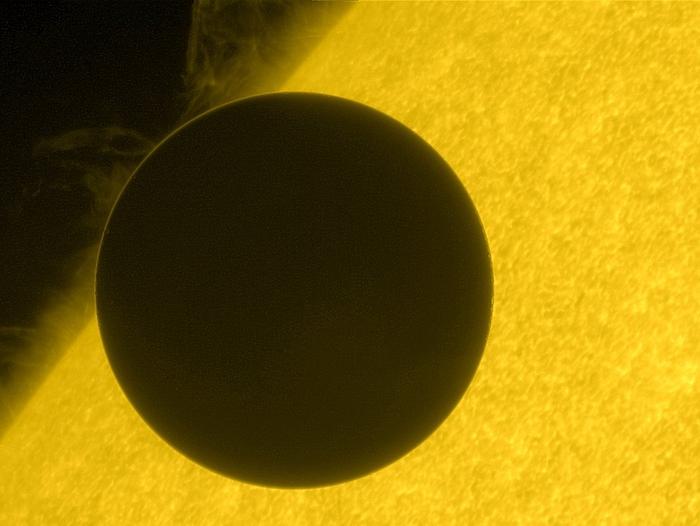M65 and M66
From NASA APOD:
Nearby and bright, spiral galaxies M65 (top) and M66 stand out in this engaging cosmic snapshot. The pair are just 35 million light-years distant and around 100,000 light-years across, about the size of our own spiral Milky Way. While both exhibit prominent dust lanes sweeping along their broad spiral arms, M66 in particular is a striking contrast in red and blue hues; the telltale pinkish glow of hydrogen gas in star forming regions and young blue star clusters. M65 and M66 make up two thirds of the well-known Leo Triplet of galaxies with warps and tidal tails that offer evidence of the group’s past close encounters. The larger M66 has been host to four supernovae discovered since 1973.
Thackeray's Globules
From NASA APOD:
These are larger dust bunnies than you will find under your bed. Situated in rich star fields and glowing hydrogen gas, these opaque clouds of interstellar dust and gas are so large they might be able to form stars. Their home is known as IC 2944, a bright stellar nursery located about 5,900 light years away toward the constellation of Centaurus. The largest of these dark globules, first spotted by South African astronomer A. D. Thackeray in 1950, is likely two separate but overlapping clouds, each more than one light-year wide. Along with other data, the above representative color image from the 4-m Blanco telescope at Cerro Tololo, Chile indicates that Thackeray’s globules are fractured and churning as a result of intense ultraviolet radiation from young, hot stars already energizing and heating the bright emission nebula. These and similar dark globules known to be associated with other star forming regions may ultimately be dissipated by their hostile environment — like cosmic lumps of butter in a hot frying pan.
We Are Stardust
by John Boswell (Symphony of Science)
Venus at the Edge
From NASA APOD:
As its June 6 2012 transit begins Earth’s sister planet crosses the edge of the Sun in this stunning view from the Hinode spacecraft. The timing of limb crossings during the rare transits was used historically to triangulate the distance to Venus and determine a value for the Earth-Sun distance called the astronomical unit. Still, modern space-based views like this one show the event against an evocative backdrop of the turbulent solar surface with prominences lofted above the Sun’s edge by twisting magnetic fields. Remarkably, the thin ring of light seen surrounding the planet’s dark silhouette is sunlight refracted by Venus’ thick atmosphere.
The Sun and Venus
Launched on Feb. 11, 2010, the Solar Dynamics Observatory, or SDO, is the most advanced spacecraft ever designed to study the sun. During its five-year mission, it will examine the sun’s atmosphere, magnetic field and also provide a better understanding of the role the sun plays in Earth’s atmospheric chemistry and climate. SDO provides images with resolution 8 times better than high-definition television and returns more than a terabyte of data each day.
On June 5 2012, SDO collected images of the rarest predictable solar event–the transit of Venus across the face of the sun. This event lasted approximately 6 hours and happens in pairs eight years apart, which are separated from each other by 105 or 121 years. The last transit was in 2004 and the next will not happen until 2117.
The videos and images displayed here are constructed from several wavelengths of extreme ultraviolet light and a portion of the visible spectrum. The red colored sun is the 304 angstrom ultraviolet, the golden colored sun is 171 angstrom, the magenta sun is 1700 angstrom, and the orange sun is filtered visible light. 304 and 171 show the atmosphere of the sun, which does not appear in the visible part of the spectrum.
via NASA


